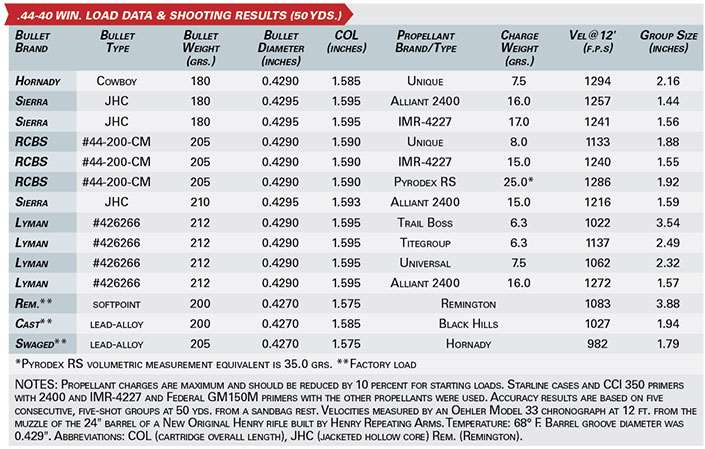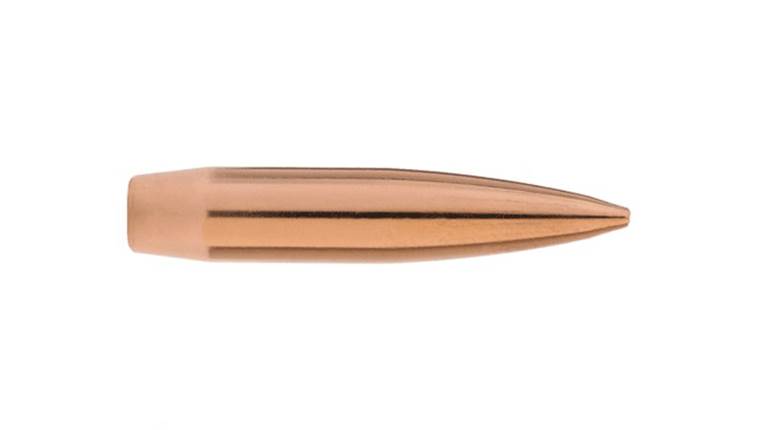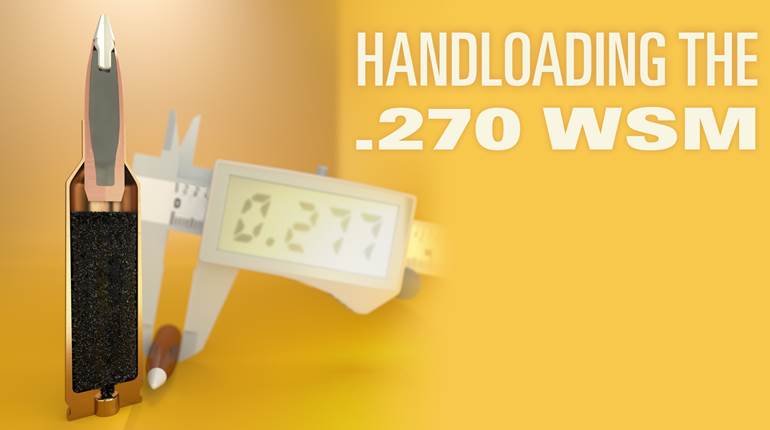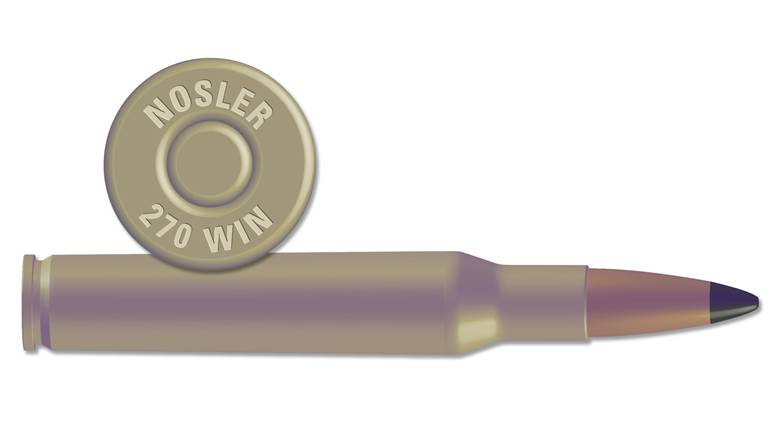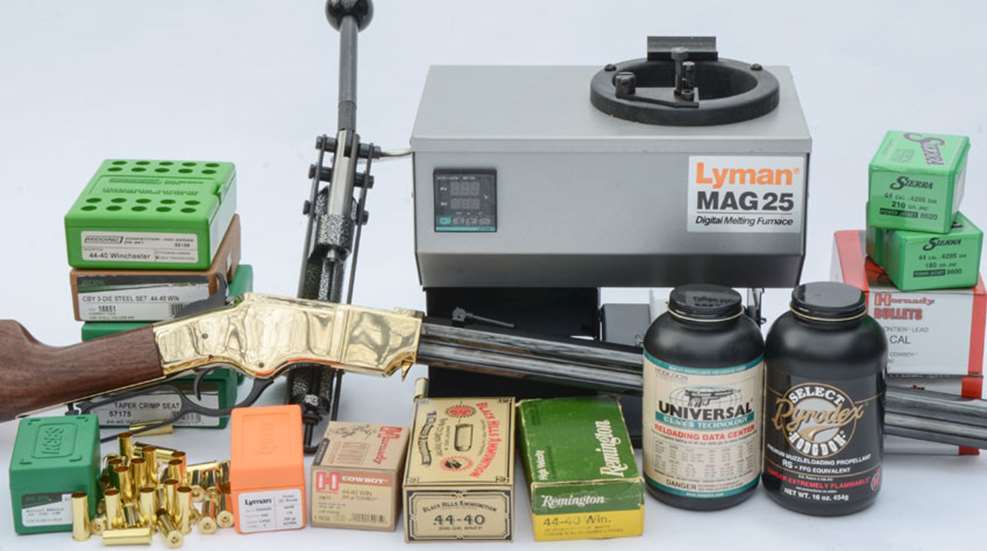
The author brought years of experience and a variety of equipment to bear on reloading for the .44-40—a cartridge that dates back more than 150 years. Diligence paid off, as accuracy of some groups for loads fired from a New Original Henry hovered near 1.5" at 50 yds.
 Introduced in the Model 1873, the .44 Winchester Central Fire, as it was originally called, was the first center-fire cartridge to become available in a Winchester lever-action rifle. Winchester also chambered experimental single-action revolvers to what we call the .44-40 Win., but what really got the attention of those who desired a handgun chambered for the same cartridge as their 1873 was its availability in Colt’s Frontier Six Shooter beginning around 1879.
Introduced in the Model 1873, the .44 Winchester Central Fire, as it was originally called, was the first center-fire cartridge to become available in a Winchester lever-action rifle. Winchester also chambered experimental single-action revolvers to what we call the .44-40 Win., but what really got the attention of those who desired a handgun chambered for the same cartridge as their 1873 was its availability in Colt’s Frontier Six Shooter beginning around 1879.
The .44-40 Win. later became available in the Winchester Model 92 as well as various rifles built by Remington, Marlin, Colt, Stevens, Ballard and others. A huge hit among hunters, it remained popular in deer camps long after the .30-30 Win. and other smokeless cartridges were introduced. Originally loaded with 40 grs. of blackpowder, the .44-40 pushed a 200-gr. lead bullet from a 24" barrel at about 1300 f.p.s. The case has a bottleneck shape with a 4 degree shoulder angle.
One of those grand old survivors that will never die, the .44-40’s health got even better when the game of cowboy action shooting came galloping hard across America starting in the 1980s. Almost overnight, domestic and foreign companies began offering rifles and revolvers chambered for it. Most were single-actions and copies of lever-action and slide-action rifles of yesteryear. Adding to the appeal, at least for me, is the Henry Repeating Arms New Original Henry (April 2014, p. 66).
 Original barrel groove diameter for the .44-40 Win. was 0.427", but SAAMI today has it at 0.4285". It varies considerably, not only among rifles from different manufacturers, but among those from the same manufacturer as well. Winchester Model 1873 dimensions seem to be the most generous, with the barrels of some reportedly measuring as large as 0.434". Foreign-made replicas of that rifle usually range from 0.426" to 0.429". The barrels of rifles being manufactured today often measure 0.429" across opposing grooves, same as for the .44 Rem. Mag.
Original barrel groove diameter for the .44-40 Win. was 0.427", but SAAMI today has it at 0.4285". It varies considerably, not only among rifles from different manufacturers, but among those from the same manufacturer as well. Winchester Model 1873 dimensions seem to be the most generous, with the barrels of some reportedly measuring as large as 0.434". Foreign-made replicas of that rifle usually range from 0.426" to 0.429". The barrels of rifles being manufactured today often measure 0.429" across opposing grooves, same as for the .44 Rem. Mag.
Bullets weighing 200 to 205 grs. in ammunition loaded by Black Hills, Hornady, Remington and Winchester measure 0.427" or close to it. While all were a bit undersize for the 0.429" groove diameter of the New Original Henry test rifle, the two loads with cast bullets delivered excellent accuracy at 50 yds. This came as quite a surprise since lead-alloy bullets usually deliver their best accuracy when sized the same as or 0.001" to 0.002" larger than the barrel-groove diameter. Jacketed bullets proved to be a different matter; the 0.427" bullet of the Remington ammunition delivered poor accuracy whereas the two 0.4295" Sierra bullets punched much smaller clusters.
The SAAMI maximum diameter at the case mouth of a loaded round is 0.443", and minimum-dimension chambers severely limit how much bullet diameter can be increased before a round becomes difficult to chamber. Outside case mouth diameter for factory ammunition loaded with a 0.427" bullet runs from 0.439" to 0.441", and increasing bullet diameter to the more readily available 0.429" takes cartridge mouth size to the limit and sometimes beyond. A Cerrosafe casting of the chamber will reveal how much room is in there.
Handloading offers the option of using various bullet diameters in the .44-40 Win., but keep in mind that some of the recommended powder charges published in the past are considered excessive today. Only up-to-date sources should be used.
Since rifles chambered for the old-timer during the past 145 years have varied considerably in the level of pressures they were designed to handle, technicians who compiled data for Lyman’s Reloading Handbook and Cast Bullet Handbook separated rifles and recommended data into two categories. Among those included in Group 1 are the Winchester 1873 and Colt Lightning (and their foreign-built reproductions) as well as various Ballard and Stevens rifles. The New Original Henry from Henry Repeating Arms featured in this report is a Group 1 rifle. Loads using 200-gr. bullets are in the 1200 to 1300 f.p.s. velocity range, and pretty much duplicate original blackpowder performance. They are held to a maximum chamber pressure of 13,700 copper units of pressure (c.u.p.).
Soon after Winchester introduced the Model 92, a high-velocity loading with a 200-gr. bullet at 1500 f.p.s. became available. Written on the box was a warning against its use in the Model 1873. Group 2 loads in the Lyman manuals are for stronger actions such as the Winchester 92 and Marlin 1894. Maximum pressure is 22,000 c.u.p., with some velocities actually exceeding that of the old Winchester high-velocity load. While Lyman’s maximum loads are deemed safe for use in a Group 2 rifle in serviceable condition, case life may be short. The first rifle in .44-40 Win. I handloaded for, a Spanish copy of the Winchester Model 92 called El Tigre, performed best with a 200-gr. bullet at 1400 to 1500 f.p.s. Case life and effectiveness on deer were quite good.
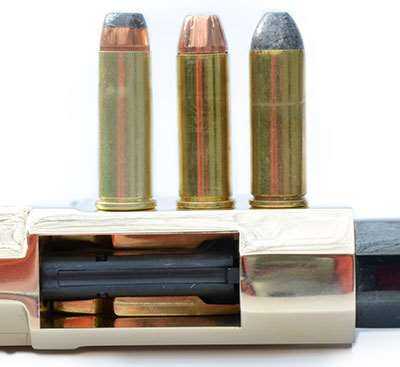
The .44-40’s biggest weakness, and one that can make it a challenge to reload, is a neck wall thickness of only 0.007" to 0.008", or about half the thickness of .44 Mag. and .45 Colt cases. Should cases in a batch vary, trimming all to the exact same length is the first step in preventing case collapse during the mouth-crimping operation.
If the inside neck diameter of resized cases is considerably smaller than bullet diameter, cases may collapse during bullet seating. For this reason, inside neck diameter of the cases in factory ammunition is only slightly smaller than bullet diameter. Whether a Lyman M die or the same type of die made by RCBS or Redding is used, an expander diameter of 0.427" is ideal for the 0.4295" Sierra bullets in virgin Starline cases, while 0.426" works as well with lead-alloy bullets measuring 0.429". This leaves case neck tension a bit lighter than when loading the .44 Mag., but it is enough when the mouth of the case is properly crimped against the bullet.
Even when using an expander of the correct size, it is not uncommon for the thin wall of the .44-40 Win. case to allow a seated bullet to end up slightly canted away from the axis of the barrel. In addition to a negative effect on accuracy, the base of a tilted bullet can bulge the case wall enough to interfere with chambering. Should this be a problem, the Competition Bullet Seating Die from Redding can be a solution. A close-fitting, spring-loaded seating stem travels downward into the body of the die to align bullet and case prior to bullet seating.
In the old days, loading enough blackpowder to fill the case to the base of a seated bullet did more than deliver as much velocity as possible from the cartridge. It also prevented the bullet from being seated deeper in the case when the cartridge was subjected to magazine spring pressure under recoil while resting in the tubular magazine of a rifle. Most smokeless powder loads do not fill the case, so in order to prevent bullet movement, some ammunition manufacturers (Remington and Winchester in particular) roll a cannelure into the case adjacent to the base of the bullet.
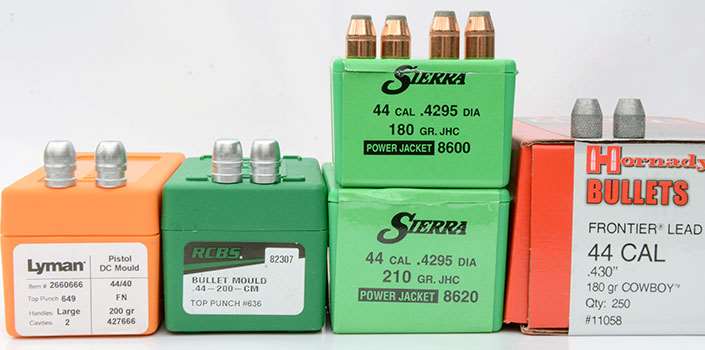
Since cannelure location varies for different bullets, it is absent on cases made by Starline. I suppose one could be applied with a tool available from Corbin, but the bullet movement problem is more easily solved by properly crimping the mouth of the case. The Factory Crimp Die from Lee Precision is one option, but I prefer a different method.
After a bullet is seated, use the roll-crimp feature of the seating die to only lightly push the mouth of the case into its groove in the bullet and then follow with a taper-crimp die. I have used RCBS Cowboy dies along with a taper crimp from the same company with great success. Another option is the Profile Crimp Die from Redding. It combines the two types of crimps into one operation.
There is another reason for using both roll and taper crimps. A heavy roll-crimp accepted by the .44 Mag. case will buckle the thin .44-40 case. The secret, through trial-and-error success, is to apply as much roll crimp as cases can withstand without buckling or bulging outward and then back it up with a taper crimp. The Hornady Cowboy bullet does not have a crimp groove, so apply just enough roll crimp to remove the bell from the mouth of the case and seat it firmly against the side of the bullet, and follow with a taper crimp.
In addition to being less expensive than jacketed bullets, those cast at home can be as accurate. The 0.427" swaged bullet in Hornady’s Cowboy ammunition is capable of delivering excellent accuracy, and its hardness of around 7 on the Brinell scale allows it to obturate to fill the grooves of a 0.429" barrel. While the 205-gr., 0.427" bullet is still available in loaded ammunition, for reloading, it has been replaced by a 180-gr. version of 0.429" diameter.
I used a Lyman Mag 45 furnace to melt lead alloy for this project and cast bullets of wheel weight metal with a BHN hardness of 10. Molds were RCBS #44-200-CM and Lyman #426266—two-cavity types dropping bullets that weighed 205 and 212 grs., respectively. Both measure 0.429". That diameter is correct for the barrel of the 1860 Henry, so the bullets were run through a 0.429" die in a Lyman 4500 Lube Sizer only to fill their grooves with Lyman’s Alox lubricant. A Lyman No. 649 top punch worked fine with both bullets.
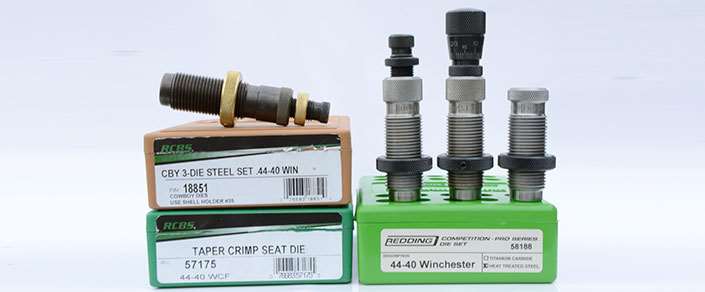
Cast bullets also work nicely in Group 2 rifles but since jacketed bullets expand, they are better for use on deer and other game. Winchester and Remington 200-gr. jacketed soft-nose bullets used to be available, but I have not seen them for sale in quite a long time. A problem with most other bullets is their cannelures are located for the .44 Mag. and in the .44-40, overall cartridge length will exceed the 1.60" maximum. The front of the cannelure must be no farther away from the nose of the bullet than about 0.290". Others might be out there, but the Sierra 180- and 210-gr. jacketed hollow cavity (JHC) bullets are the best options I have come up with. Cannelure location is perfect for the .44-40, and accuracy leaves nothing to be desired.
As seen in the test results chart, accuracy from a rifle/cartridge combination that dates back over 150 years can be quite good. With the exceptions of a magazine follower in safety orange and the .44-40 Win. chambering in lieu of the original .44 Rimfire, the test rifle from Henry Repeating Arms of New Jersey is precisely the same as the one created by Benjamin Tyler Henry when Oliver F. Winchester was still in the business of making shirts. It is, without doubt, one of the most fun rifles I have ever shot, not to mention it boasting a rate of fire unmatched by any other rifle used in the American Civil War, including the Spencer.
